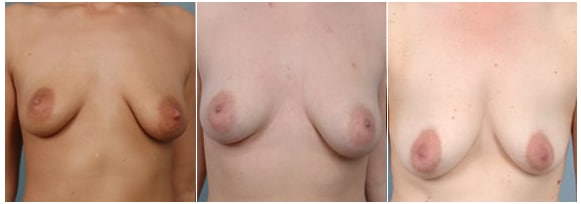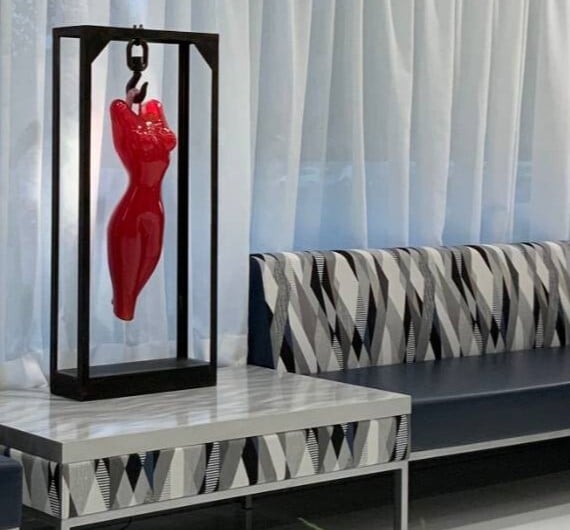*Individual results may vary
Asymmetry of the female breast is a normal, frequent finding. The degree of asymmetry is variable as well. Most of the time, asymmetry is to a small degree, with both breasts still within the same cup size. Occasionally, the breasts are of different cup sizes.

Certainly, one of the goals of breast augmentation is to create symmetrical breasts. When the breasts are symmetrical to begin with, symmetry after surgery is usually possible. I want to make it clear that no two breasts are perfectly symmetrical. When I use the term “symmetrical”, I mean the breasts appear symmetrical upon casual glance, not under close scrutiny and detailed inspection.
The best way to think of the breast is to separate it into two parts:
- The breast envelope which is the skin that forms the “bag” that contains the breast tissue
- The fat and glandular tissue that forms the “filling” of the breast.
I find the Ziploc “water filled bag” analogy very helpful when explaining breast augmentation with my patients. Let’s look at a couple of case scenarios:
- Case scenario 1: If you have two quart size bags, one filled with 1/2 quart water and the other filled with 3/4 quart water, then one can achieve symmetry by adding 1/2 quart water to the first bag and 1/4 quart water to the second bag. The volumes are the same and the bag size is the same, so the resultant appearance is symmetrical.
- Case scenario 2: Now let’s use two different bags; one sandwich size and one quart size. Let’s say you have 1/4 quart water in the sandwich bag and 1/2 quart water in the quart size bag. If you add (lets assume it is possible without the bag bursting) 3/4 quarts water to the sandwich bag and 1/2 quart into the quart size bag. The result is equalization of volumes between the two bags, but the smaller sandwich bag is very over-distended and the quart size bag is appropriately filled. The sandwich bag will look round and tense, and feel overly firm. The quart size bag will look more “natural” in shape but filled out more, certainly not distorted. Probably, the overstretched sandwich bag will stretch over time and look less tight and overfilled, but never will resemble the quart size bag.
What is the message here?
If two breasts have similar skin envelopes but one is slightly filled more than the other, then using breast implants with slightly different volumes so as to achieve the same volume on each side can approach symmetry (not exactly, but closer in symmetry). As the breast implant is not an exact replacement for breast tissue, even when you have similar “bag sizes” but different starting tissue volumes, equalizing breast volume will usually yield a very good result, but not perfect symmetry*. However, if the skin envelopes are markedly different, then using implants with different volumes will achieve better symmetry in volume, but shape will still be dissimilar. The more dissimilar the skin envelopes are and the more dissimilar the natural breast volume is, the harder it is to achieve symmetry with two different size implants. What is the reality? In my experience, in the vast majority of such cases, even when the breasts are asymmetric to start with, when I need to use different size implants coupled with appropriate counseling of my patient, the end results have been beautiful and the patients have been very happy with the results*. Examples of breast augmentation with differing size implants can be found in my photo gallery.
Sometimes, the difference in the breasts is so great in terms of not only the starting volume, but also the breast envelope size and shape that two procedures are required. The first is usually a reduction (which by definition includes a lift) of the larger, more ptotic (droopy) breast with or without a lift of the smaller breast as indicated. Why do I do this in two stages? There are just too many variables here to try to correct with one surgery. Healing is an unpredictable factor. If we do a reduction on one side, with or without a lift on the other, then the goal is to make the breasts as similar as possible, even though we are not making them any larger yet. Let the breasts heal. The volume and shape differences present at the end of the first surgery will be different at the time of the second surgery. The nipples will be of similar height and position on the breasts. During the second surgery approximately six months later, all that we need to worry about is a modest difference in volume – the breast envelope changes, the nipple position, and the bulk of the volume differences were already taken care of by the first surgery. Now we just tweak it with two implants of similar, or slightly differing sizes. Generally, a volume difference of up to about 100 – 130 cc can be taken care of with just implants alone. See examples of this approach here.
Next Section: Breast Augmentation with Fat »
Next Section: How far apart will my breasts be? Will I have cleavage? »
Sections – What Else Should I Know
- Breast Augmentation with Fat
- Will my breasts be symmetric?
- How far apart will my breasts be? Will I have cleavage?
- The truth about incision size
- Do breast implants need to be routinely changed?
- Things We Cannot Control: Wound healing, tissue stretch and gravity
- Breast Augmentation and Lactation
- Setting realistic expectations for your result
- Breast Implant Rupture – How To Know? – Are Routine MRI Scans Really Necessary?
- Mondor’s Cords – What Are They?
Prev Chapter: Breast Lift (Mastopexy) with/without Implants or Fat »
Next Chapter: Important Things to Consider When You Decide to Move Forward With Breast Augmentation »
Chapters – Breast Augmentation Guide
- Intro to Breast Augmentation
- Motiva Breast Implants
- Five key decisions you need to make
- One-Day Recovery Breast Augmentation
- Anesthesia – General, Sedation or Local?
- Breast Lift (Mastopexy) with/without Implants or Fat
- What else should I know about breast augmentation?
- Important Things to Consider When You Decide to Move Forward With Breast Augmentation
- Revision of breast augmentation
- ALCL and Breast Implant Illness


